![]()
![]()
![]()
Use LEFT and RIGHT arrow keys to navigate between flashcards;
Use UP and DOWN arrow keys to flip the card;
H to show hint;
A reads text to speech;
40 Cards in this Set
- Front
- Back

|
- bilateral symmetry (cephalization) - mostly parasitic - aceolomate (cavity is digestive tube) - tripoblastic (3 germ layers) -branched intestine: extracellular & intracellular digestion (exception: cestoda (diffusion)) - eyespots (ocelli) -monoecious (sperm AND egg) - no respiratory/circulatory system |
|

Liver Fluke Life Cycle |
1. Human eats raw fish |
|
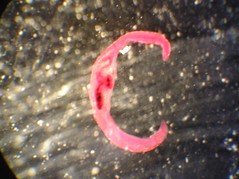
Schistosoma |
* dioecious blood flukes "schistosomiasis" - liver, spleen, urinary bladder, intestine 1. larva burrow into human 2. adults reproduce in blood vessels 3. eggs pass into intestine 4. eggs leave with feces 5. miracidium 6. snail intermediate host 7. cercaria larva
|
|
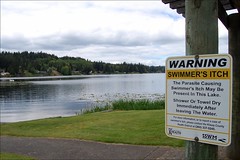
Schistosome dermatitis |
* schistosome dermatitis * cercaria larva penetrates inappropriate host * definitive host - waterfowl * intermediate host - snail * northern lakes in N. America |
|
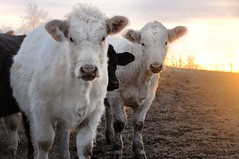
life cycle of beef tapeworm |
* human eats rare beef that contains the parasite * larva grows into adult and reproductive in intestine * eggs shed in feces * cow ingests egs * larva forms cysts in muscle |
|
|
worm vocab |
scholex - anterior, head region strobila - rest of body, made of proglottids immature proglottids - grow from the head (scholex) gravid proglottid - ready to be realeased |
|
|
protostomes |
proto: first stome: mouth - mouth forms first - spiral cleavage - mosaic embryo - schizocoely (coelom formed when split mesodermal embryonic tissue) |
|
|
deuterostomes |
- blastopore becomes anus - radial cleavage - regulative embryo - enteroceoly |
|
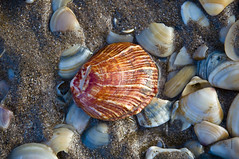
Phylum Mollusca |
- carnivores, herbivores, scavengers, filter feeders, parasites -bilateral symmetry -ceolomate, protostomes -mantle cavity - gills - complete digestive system
|
|
|
Mollusca continued (layers) |
foot (locomotion,attachment,burrowing) -exoskeleton -prismatic layer: calcerous, in a protein matrix -narceous layer: inntermost layer, many thin layers, mother of pearl |
|
|
Mollusca circulatory system |
- open circulatory system (blood/hemolymph, pumping organ, blood vessels/spaces) transport oxygem, nutrients, hormones romoves metabolic wastes -interstitial fluid: fluid between cells, medium for diffusion -heart -hemolymph bathes cells -hemocoel, network of sinuses |
|
|
Mollusca excretory, nervous, sexual |
- excretory system - metanephridia (kidneys) functions to move waste -nervous system: brain, well-developed sensory structures -sexual reproduction: most dioecious internal or external fertilization (sperm in water, or male does it to female) |
|
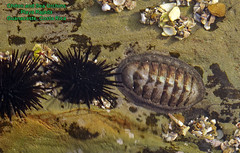
Class Polyplacophora (Chitons) |
meaning: many plates cell composed of 8 overlapping plates -reduced head -no eyes or tentacles -get exposed when tides go out |
|

Class Gastropods (snails) |
-largest and most diverse class -well developed head (distinctive), tentacles, eyes -univalve shell: spirally coiled (mostly), flattened, or no shell top tip = shell apex opening = aperture sinistral = aperture opens left
|
|
|
Gastropod tension |
tension is unique to gastropod - rotation of visceral mass 180 degrees during development -anus becomes twisted to where it is above head -one side of bilaterally symmetrical larva grows more rapidly than the other side -anus and gill come to lie above head why: adaptation to protect head ^^^ |
|

Class Bivalvia (clams, oyster, scallop, shrimpworm) |
-foot used for burrowing -body laterally compressed -two part shell (hinged dorsally, open ventrally) adductor muscle is strong, opening and closing allows to swim - no brain -some have eyespots and can see, but most dont |
|
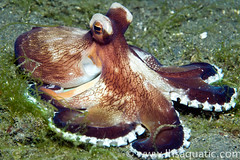
cephalopoda (squid, octo, cuttlefish, nautilus) |
cepha(head) lo poda(foot) -fast swimming predators, mouth surrounded by arms/tentacles, arms w/suckers -very well developed eyes -shell reduced or absent (except for nautilus)
|
|
|
cephalopoda (communication and defense & sexual reproduction) |
-color change (chromatophores) -camouflage & confusion of predators -ink = temp. blinds predator -male transfer spermatophores w/ hectocotylus she can throw away, or use to fertilize -they communicate alot
|
|
|
pseudoceolomote animals |
- nematoda - parasites (ascaris lumbricoides, trichinosis, pinworms, filarial worms, hookworms) - rotifera |
|
|
Phylum Nematoda (round worms) |
-parasitic, plants and animals -important ecologically: decomposition, nutrient recycling -hydrostatic skeleton -slender elongated bodies, tapered at both ends -tough cuticle -longitudinal muscles; characteristic movement -eutely (means they have constant # of cells, exact) -complete digestive - dioecious but possible monoecious, usually sexually dimorphic, internal fertilization |
|
|
Ascaris lumbricoides |
- specific intestinal human parasite -reproduce in intestine of humans and feed on intestinal content - eggs released in feces, in order for someone to get infected have to ingest eggs (seaweed not washed properly)
|
|
|
trichinosis |
-undercooked pork or bears -larve in muscle, when eat, released into gut -grows in gut (intestines) -form cyst in muscle
|
|
|
pinworms |
-most common helminth (intestinal parasite) in humans in USA -30% children, 16% adults are infected -females lay eggs in anal region at night, crawl out of anus at night lay eggs and die -only ones to exhibit haplodiploidy (males = haploid, develop unfertilized eggs, female = diploid and develop from fertilized eggs) |
|
|
filarial worms |
-in humans (elephantisis, river blindness) -in dogs and cats (heartworm)
transmitted by biting flies (black flies, mosquitoes) |
|
|
hookworms - intestinal phase |
- larva burrow through skin or ingested - larva makes way to alveoli, enter trachea, swallowed -adults reproduce in intestine, eggs shed in feces -cut into intestinal lining and feed on blood |
|
|
pylum rotifera |
- name means "wheel bearer" because of cilia on head - eutely - fixed # of cells - cuticle - tripoblastic - complete digestive tract -suspension feeders -mastax -extracellular digestion -mastax (pharynx) (muscles and jaws, feeding structures) - nervous system with brain and sensory structures -excretory system - protonephridia |
|
|
Arthropoda (arthropod = jointed feed) |
-bilateral ceolomate, protostome, jointed appendages exoskeleten - chtin hard, yet lightweight advantages: -support, muscle attachment, prevention of water loss, protection open circulatory: hemolymph instead of blood |
|
|
Arthropod = 5 subphyla |
1. trilobita 2. chelicerata 3. myriapoda 4. crustacea 5. hexapoda |
|
|
trilobota |
-extinct 200 million years -bottom dwellers -prob. scavengers -3 longitudinal lobes -single pair antennae -biramous appendages |
|
|
chelicerata (horseshoe crab, spiders, scorpions, ticks, mites) |
-cephalothorax & abdomen -noantennae - only group w/o -food manipulation -defense -copulation -4 pairs of walking legs |
|
|
merostomata (horseshoe crab) |
living fossils
build nests in sand
external fertilization |
|
|
Class Arachnida |
-most carnivorous -eat other arthropods -many use chelicerae to inject poison into prey -almost all are terrestrial -strong sucking pharynx |
|
|
Crustacea |
-mostly aquatic -primarily marine -microscopic zooplankton -exoskeleton often calcified -compound eyes -head -2 pairs of antennae -cehpalothorax & abdomen -biramous appendages |
|
|
Subphylum myriapoda (centepedes and millipedes)
|
-Terrestrial -paired appendages on most segments -tagmata: head and trunk -uniamous appendages -one pair antennae |
|
|
Class Chilipoda (Centipedes) |
- Tagmata= head + trunk - 1st trunk appendages form poison claws -carnivorous, fast -prefer moist habitats -mostly harmless |
|
|
Class Diplopoda (millipedes) |
- Each trunk segment - 2 pairs of appendages - 2 spiracles - most are herbivorous - prefer dark, moist habitats - slower moving - repugnatorial glands & coil as defense |
|
|
Subphylum Hexapoda, Class Insecta |
- mostly terrestrial - many freshwater - very few marine species
tagmosis = head,thorax,abdomen
-uniramous appendages -one pair of antennae -respiration with tracheae |
|
|
Cuticle - Exoskeleton |
- complex system of plates called sclerites - chitin embedded in protein matrix - sensory hairs - schleroproteins unique to insects - rigidity & lightness (flight) |
|
|
Metamorphasis |
Hemimetabolous (incomplete)
Homometabolous (complete) |
|
|
Insect highly varied feeding habits |
* Phytophagous (herbivorous)
* Saprophagous * Carnivorous (predaceous) * Parasitic |

